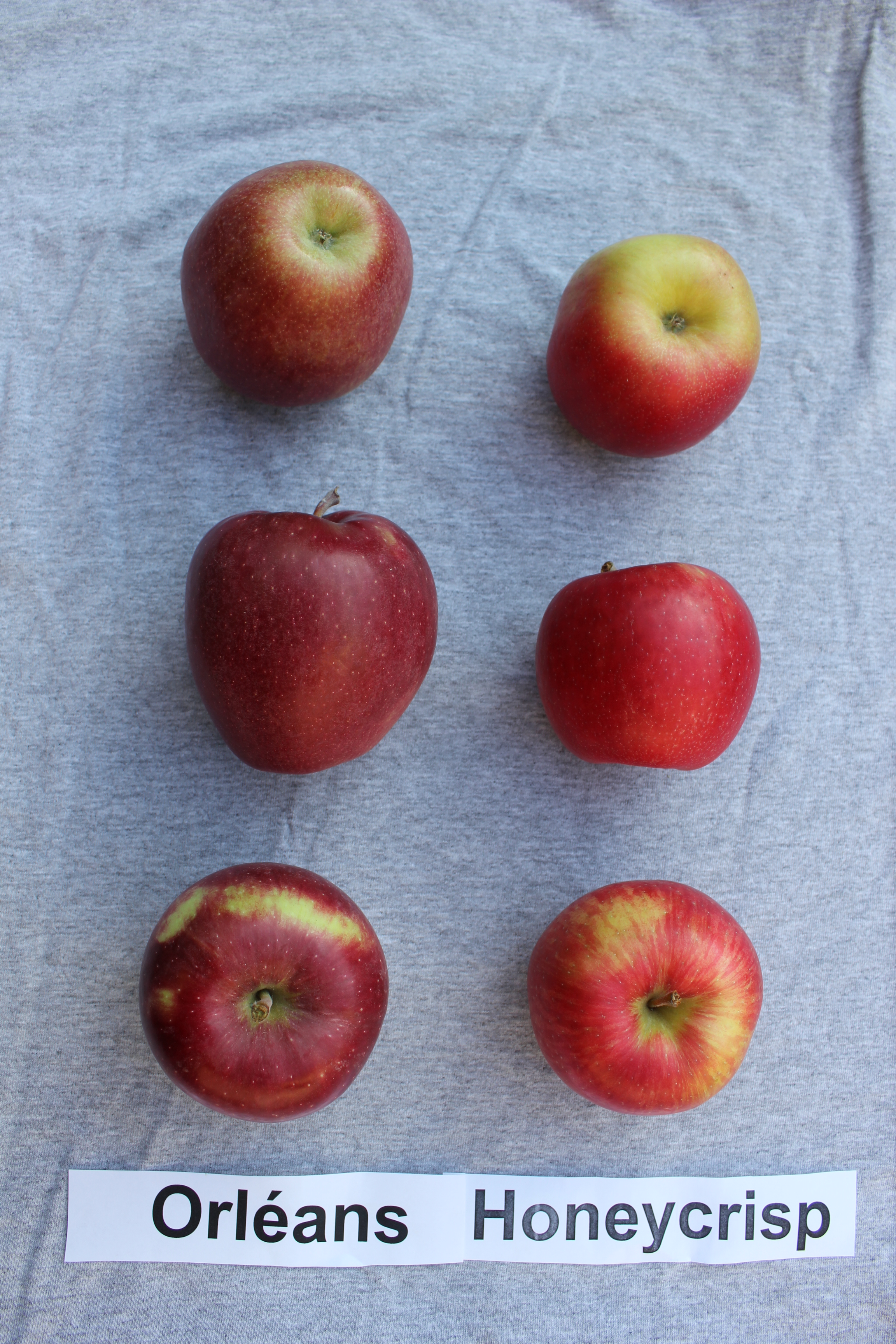Orléans
| Denomination: | 'Orléans' |
|---|---|
| Botanical Name: | Malus domestica |
| Applicant/Holder: |
Mantha, Serge 2595 rue de Mont-Joli Québec, Quebec G1V 1C4 Canada |
| Breeder: |
Serge Mantha, Québec, Quebec |
| Application Date: | 2015-11-19 |
| Provisional Protection:: | 2015-11-19 |
| Application Number: | 15-8752 |
| Grant of Rights Date: | 2017-08-17 |
| Certificate Number: | 5530 |
| Grant of Rights Termination Date: | 2042-08-17 |
Variety Description
Variety used for comparison: 'Honeycrisp'
Summary: The tree of 'Orléans' has a weeping growth habit and strong vigour, whereas the tree of 'Honeycrisp' has a drooping growth habit and weak vigour. 'Orléans' bears fruit on long shoots only while 'Honeycrisp' bears fruit on both spurs and long shoots. The one-year-old shoot of 'Orléans' is of medium thickness, whereas it is thin on 'Honeycrisp'. The internode of the one-year-old shoots of 'Orléans' is longer than that of 'Honeycrisp'. The pubescence on the distal half of the one-year-old shoot of 'Orléans' is strong while it is absent or very weak in 'Honeycrisp'. At the balloon stage, the petals of 'Orléans' are dark pink, whereas they are light pink on 'Honeycrisp'. The general shape of the mature fruit of 'Orléans' is conical while it is globose and obloid in 'Honeycrisp'. The fruit of 'Orléans' is taller than that of 'Honeycrisp'. The overcolour of the skin on the fruit of 'Orléans' is purple red and distributed over a very large area while it is red and distributed over a large area in 'Honeycrisp'. 'Orléans' has a longer fruit stalk than 'Honeycrisp'. The fruit of 'Orléans' has a large number of medium-sized lenticels, whereas the fruit of 'Honeycrisp' has a medium number of small-sized lenticels. The stalk cavity and eye basin of 'Orléans' are both of medium depth, whereas they are deep in 'Honeycrisp'. The fruit flesh of 'Orléans' is greenish while it is yellowish in 'Honeycrisp'.
Description:
TREE: strong vigour, ramified type, weeping habit, bearing on long shoots only, begins flowering mid-season
ONE-YEAR-OLD SHOOT: medium thickness, dark brown on sunny side, dense pubescence on distal half, many lenticels
LEAF: outwards attitude in relation to shoot, high length to width ratio, dark green on upper side, serrate type two margin, medium pubescence on lower side
PETIOLE: medium extent of anthocyanin colouration
FLOWER: dark pink at balloon stage, large diameter when petals pressed into horizontal position, overlapping arrangement of petals, stigma at the same level as anthers
YOUNG FRUIT: small extent of anthocyanin colouration
FRUIT: large, medium height to diameter ratio, conical shape, absent or weak ribbing, absent or weak crowning at calyx end, medium-sized eye, medium-length sepals, late-season harvest maturity and eating maturity
FRUIT SKIN: absent or weak bloom, absent or weak greasiness, green ground colour, very large area of overcolour, purple red overcolour distributed as a flush and mottling of strong intensity with narrow stripes; absent or small area of russet around stalk attachment and on cheeks and around eye basin, large number of medium-sized lenticels
STALK: medium thickness
STALK CAVITY: medium depth and width
EYE BASIN: medium depth and width
FRUIT FLESH: firm, greenish, fully open aperture of locules in transverse section
Origin & Breeding History: 'Orléans' (experimental designation Orléans 3) originated from a cross between 'Empire' and 'Honeycrisp' conducted in 2002 in Sainte-Famille, île d'Orléans, Quebec. The seeds from this cross were planted in an evaluation block in 2003 at the same location. In 2009, one seedling of Orléans 3 was selected. The material from this seedling was propagated on three commercial rootstocks and the resulting trees were planted in two blocks at the same location. Evaluation began in 2012, and the selection criteria included fruit colour, size, shape, firmness, texture, flavour and shelf life.
Tests & Trials: Trials for 'Orléans' were conducted from 2012 to 2016 at the Ferme Avicole Orléans in Sainte-Famille, île d'Orléans, Quebec. Plots consisted of 10 trees of each variety, spaced approximately 1.8 metres apart within the row and rows spaced 3.6 metres apart. Both the candidate and reference varieties were grafted onto 'B9' rootstock. The trees of the candidate variety were planted in 2012 in the row adjacent to the trees of the reference variety, which were planted in 2003. The number of fruit per tree and the number of fruit-bearing branches were adjusted to result in a similar fruit density on each tree. Observations and measurements were taken in 2016 from 10 trees or parts of trees of the candidate and reference varieties. Mean differences were significant at the 5% probability level based on a paired Student's t-test.
Comparison tables for 'Orléans' with reference variety 'Honeycrisp'
Length of internode of one-year-old shoot (cm)
| 'Orléans' | 'Honeycrisp' | |
|---|---|---|
| mean | 3.21 | 2.45 |
| std. deviation | 0.39 | 0.58 |
Fruit height (cm)
| 'Orléans' | 'Honeycrisp' | |
|---|---|---|
| mean | 7.75 | 6.86 |
| std. deviation | 0.49 | 0.33 |
Stalk length of fruit (cm)
| 'Orléans' | 'Honeycrisp' | |
|---|---|---|
| mean | 2.94 | 2.30 |
| std. deviation | 0.28 | 0.36 |
Click on image for larger view

Apple: 'Orléans' (top) with reference variety 'Honeycrisp' (bottom)
Click on image for larger view

Apple: 'Orléans' (left) with reference variety 'Honeycrisp' (right)
- Date modified: